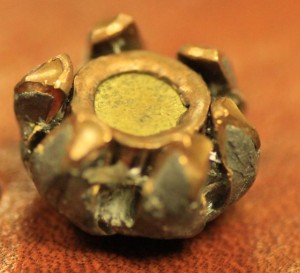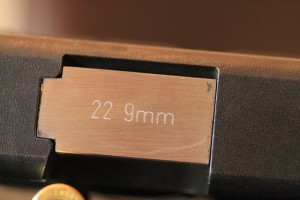Widgetized Section
Go to Admin » Appearance » Widgets » and move Gabfire Widget: Social into that MastheadOverlay zone
Being Wrong is Important… and, admitting it is too! – (Or: Why Rob Pincus prefers the 9mm over the .40 for personal defense)
 As followers of the DRTV Blog for the past few years know, I don’t publish a newsletter very often. A few times a year, I share an update with our followers and those interested in our programs, but we try not to overrun inboxes with something every week or even every month. I like to think that means that when we do take the time to send one out, many of our 10,000+ subscribers and those who become aware of the posting through various websites actually take the time to read through the whole thing.
As followers of the DRTV Blog for the past few years know, I don’t publish a newsletter very often. A few times a year, I share an update with our followers and those interested in our programs, but we try not to overrun inboxes with something every week or even every month. I like to think that means that when we do take the time to send one out, many of our 10,000+ subscribers and those who become aware of the posting through various websites actually take the time to read through the whole thing.
Just in case you didn’t know we had a new newsletter out, or if you missed this particular article, I wanted to share it here. While the 9mm vs. 40 debate probably gets too much attention, the underlying theme of this article probably doesn’t get enough. I look forward to comments and feedback!
In my last book, Combat Focus® Shooting: Evolution 2010, I took some space to talk about the importance of Evolving. I think one very important contributor to your ability to evolve is your ability to look backwards and see what you were wrong about… or, at least, being able to recognize the things that you have changed your mind about!
In the section of the book where I talked about how important this process of evolution was, I listed a few things that I had “changed my mind about”. What I did not do was explain specifically which way I felt on the topics today… Honestly, I thought at the time that my current position would be obvious. Many readers have asked my to clarify my position on a couple of the topics. The number one request is to clarify whether I prefer the 9mm or the .40S&W for personal defense. In the mid-90’s I became convinced that the 9mm was an anemic round not well suited to defensive duty. Now, I don’t think you’ll find any articles or even forum posts were I rant about how only a fool would carry it, but I personally considered it a great compromise. Particularly when I moved into a county that required anyone applying for a CCW permit to qualify with either a .38 revolver or a 9mm pistol. At the time considered the 1911 in .45acp a great choice for personal and home defense (another thing that I have notoriously changed my mind about dramatically in the past couple 15 years!) and was very frustrated by this restriction. I begrudgingly bought a Taurus PT series firearm in 9mm, which allowed me to carry “cocked & locked” in the manner I generally trained during those years. Luckily for me, and the other residents of the state of Tennessee, that restriction was lifted not too long afterwards and I was able to carry any firearm I wanted for personal defense. During that time, I had come to decide that the Glock 23 with 13+1 rounds of .40S&W ammunition was about as close to perfect a defensive pistol as someone could want… and I considered its rounds significantly superior to 9mm. This is definitely something that I now look back and I think I was wrong about.
I have heard many an instructor say that they are “always a student” or that they “never stop learning,” but over the past couple of years, I have had the opportunity to ask dozens of professional instructors to identify some specific things that they have changed their minds about. Often, I have been disappointed with the trouble that so many have had with the question. At one point during the taping of our second season, I even considered giving the topic up as a “Question of the Week” on the S.W.A.T. Magazine TV show because it was so difficult getting guests to answer the question directly. Now don’t get me wrong, I don’t think that my peers are being insincere where they claim the badge of “student” or say that they are “open minded,” but I have seen enough stuttering, confused looks and awkward body language to know that this question strikes a nerve. Let me give you an idea of how it often goes:
Me: “What is one specific thing that you have change your mind about since you’ve been instructing?”
Instructor: (after a pause and settling back into their chair a little) “oh, well…we are constantly evolving.”
Me: “Can you think of anything specific?”
Instructor: (often with a look of relief, like they found the exit hatch…) “Well, there’s been a lot of things.”
Me: “Of course, but is there any one thing that you can look back on, which you actually used to teach, that you would now say is ‘wrong’”?”
Instructor: (shifting glance or two, more settling) “I wouldn’t say that anything was “wrong”, but some things are better than others.”
Me: “What are some of the things you’ve actually taught in the past that you now believe are ‘worse’ than other things?”
Instructor: “uh….”
Now, certainly, that isn’t verbatim for any dialogue, nor would it be fair to characterize ANY of the instructors I’ve posed the question to as being evasive. There is a huge difference in someone who is trying to hide the fact that they have been wrong and someone who has simply not thought about it that way and is not used to being asked to articulate it. Especially with a camera in their face or standing in a group of peers at a conference! I have come to realize that the many of these guys, including friends of mine, have trouble articulating the fact that they once taught something that they do not today believe is the best information… or, put more simply, they aren’t used to publicly admitting they were wrong about something specific. It is very easy to admit that you have been wrong in general or that you are open to changing your mind, but there is definitely a stumbling block for many people when we try to get to a detail level.
For me, while it may be frustrating and/or disappointing to find out I was wrong about something, I have learned to balance that negative with what I think is a much more significant positive: Learning Something Better. While this isn’t always the case, at the very least I can celebrate the intellectual experience of knowing that I need to seek out a new answer when a theory or technique has been rendered invalid. Some instructors have articulated to me that they feel like changing what they teach is somehow a disservice to those whom they have taught before. While I understand that gut reaction, it is at least as much of a disservice, combined with an integrity issue, to not teach your future students things that you believe with conviction are the best options.
So, why do I think the 9mm is a better choice for personal defense than the .40 S&W?
1. The Myth of the “One Shot Stop”, Part 1: Faster Strings of Fire are Better.
I don’t believe that it is likely to take only one shot to stop your next threat. With this in mind, the “data” that we collect (and sometimes obsess over) about the difference in potential terminal performance from one bullet to the next or the relatively few examples we have of single pistol hit results in human beings suggests to me that we should plan on multiple shot strings of fire. If we are planning on needing more than one shot and we know that we want to stop the bad guy as soon as possible, then it makes sense that we should seek the fastest string of fire possible. Physics dictates that the 9mm is going to be a more manageable round (lower recoil) than the .40 S&W out of any particular firearm. So, no matter how much you train and how much you practice, everyone should be able to shoot a string of Combat Accurate 9mm rounds faster than they can fire a string of .40. Of course, if you consider a 4×8 sheet of plywood your “combat accurate” area, you’re going to have to go to a relatively long string of fire to be able to measure a difference in time, but if you stick with a probable target size (high center chest) at a plausible distance (10-15’), it shouldn’t be hard to see a difference at a reasonable number of rounds (3-6).
2. The Myth of the “One Shot Stop”, Part 2: Higher Capacity is Better.
Again, keep in mind that we are counting on needing more than one round. In any given size package, 9mm firearms hold more rounds than their counterparts chambered in .40 S&W. This gives you a greater potential for defense against one or more targets for the same practical cost in size & weight.

9mm or .40 ?? Bet you can't tell. In a recent test, the PDX1 .40 and 9mm performed almost exactly the same in the gelatin.
3. Negligible Difference in Practical Wounding Potential.
Pistol bullets really aren’t great stoppers. There is a reason that hospital emergency rooms successfully treat Gun Shot Wound patients on a regular basis. Having talked to many EMTs and trauma doctors, and examined a significant amount of pictures/medical reports, there is a negligible difference between the wounding capacity of the 9mm and the .40 S&W. The idea of “energy transfer” is misplaced in regard to wounding potential because the net amount of energy contained in a pistol bullet is pretty low when we think about really having dramatic effect on a human body (knocking someone down, for example). The damage that is done is created through cutting and crushing. The difference of a few grains of weight, a few feet per second of speed or a millimeter (literally) of diameter are not worth giving up on the faster strings of fire or the higher capacity mentioned above. While the .40 S&W round, especially in heavier versions, has more potential for penetration of intermediate barriers, the data on actual personal defense shooting suggests overwhelmingly that there are not likely to be any hard barriers to be penetrated. (Law Enforcement Officers face barriers much more often, presenting a stronger argument for the .40 in the role of police duty gun). Tom Givens’ Lessons From the Street DVD is a great example of real world self defense shooting data of the type that should be influencing our choices.
There is also a large body of testing evidence that modern bonded hollow points in 9mm will penetrate an adequate amount of tissue to cause a maximum amount of damage inside a human body. In fact, manufacturers such as Winchester are now designing their defensive rounds to have consistent performance across the most common defensive calibers (9mm, 40, .45, .38). I recently participated in a ballistic gelatin demonstration of that company’s PDX1 line of ammunition and saw for myself that they are achieving this goal.
It is important to note that I am not arguing that a single .40S&W bullet doesn’t hold more potential to stop in any event, rather I believe that the small increase in potential is not worth the absolute known detriments in recoil and capacity. As I discussed in point number one, for all shooters, at some point, there will be a moment when they can fire one more round of 9mm in any given period of time. That extra round’s capacity to wound will far outweigh the miniscule difference in potential for any individual bullets.
4. Lower Cost, High Value Practice
It is significantly less expensive to shoot 9mm in training than it is to shoot .40… that means more reps and more training in general for any given budget. This is the last reason I’m going to offer here, but there is no doubt that it is a factor in favor of choosing the 9mm. This is not an argument for training with loads that aren’t what you actually carry just because of budget (training with a .22lr, for example), it is an argument for training with your actual carry caliber and carry gun as often and as realistically as is practical.
There you have it. Those are the four primary reasons that I now recommend 9mm as the personal defense round of choice, have been converting my own personal .40 S&W firearms over to 9mm and would never purchase a .40 S&W firearm for personal defense if I were starting all over today. I let anyone who asks me about defensive guns or bullets know how I feel today, despite years of recommending the .40 and talking about how it was a great compromise between the 9mm and .45. In the mid-90’s I was wrong about the advantages of that round and I have definitely changed my mind about the inadequacies of the 9mm. Acknowledging that I was wrong in the past, is the only way that I can share what I now believe is the best recommendation I can give.
-RJP
42 Responses to Being Wrong is Important… and, admitting it is too! – (Or: Why Rob Pincus prefers the 9mm over the .40 for personal defense)
You must be logged in to post a comment Login




 MidwayUSA
MidwayUSA Ruger Firearms
Ruger Firearms SCCY Firearms
SCCY Firearms Streamlight
Streamlight Action Targets
Action Targets Gunsite Academy
Gunsite Academy
Pingback: SayUncle » Rob Pincus reads the gun blogs
Pingback: Is this sound rational behind going with the Shield .40?
Pingback: PPQ M2 caliber choice - Page 2 - WaltherForums